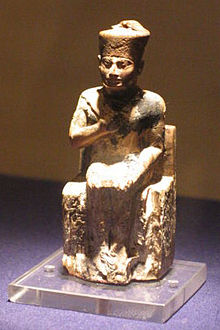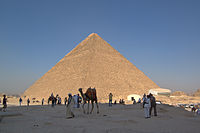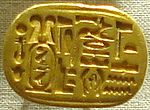- Khufu
-
This article is about a Pharaoh. For a cipher, see Khufu and Khafre.
Khufu Cheops, Suphis 
Statue of Khufu in the Cairo MuseumPharaoh of Egypt Reign 2589–2566 BC[1][2] (63 years according to Manetho); (23 years according to modern historians) [3], 4th Dynasty Predecessor Sneferu Successor Djedefre -
Nomen: Khufu
Protected by Khnum[4] -






-
Horus name: Medjedu
Mḏd.w -



-
Nebty name: Nebty-r-medjed
Mḏd-r-Nnb.tj -



-
Golden Horus: Bikwy-nub
Bjk.wj-nb.w -




-
Consort(s) Meritites I, Henutsen, plus two other queens whose names are not known[1] Children Kawab, Djedefhor, Hetepheres II, Meritites II, Meresankh II, Baufra, Djedefra, Minkhaf I, Khafre, Khufukhaf I, Babaef I, Horbaef, Nefertiabet, possibly Khamerernebty I, possibly Nefermaat II[5] Father Pharaoh Sneferu Mother Queen Hetepheres I Died 2566 BC Monuments Great Pyramid of Giza, Khufu ship ![Aa1 [x] x](/w/extensions/wikihiero/img/hiero_Aa1.png)
![G43 [w] w](/w/extensions/wikihiero/img/hiero_G43.png)
![I9 [f] f](/w/extensions/wikihiero/img/hiero_I9.png)
![G43 [w] w](/w/extensions/wikihiero/img/hiero_G43.png)
Khufu
in hieroglyphsKhufu (
/ˈkuːfuː/ koo-foo), also known as Cheops (
 /ˈkiːɒps/ kee-ops; Greek: Χέοψ, Kheops) or, in Manetho, Suphis (
/ˈkiːɒps/ kee-ops; Greek: Χέοψ, Kheops) or, in Manetho, Suphis ( /ˈsuːfɨs/ soo-fis; Greek: Σοῦφις, Souphis), was a Pharaoh of Ancient Egypt's Old Kingdom. He reigned from around 2589 to 2566 BC. Khufu was the second pharaoh of the Fourth Dynasty. He is generally accepted as being the builder of the Great Pyramid of Giza, one of the Seven Wonders of the Ancient World. Khufu's full name was "Khnum-Khufu" which means "the god Khnum protects me."[6]
/ˈsuːfɨs/ soo-fis; Greek: Σοῦφις, Souphis), was a Pharaoh of Ancient Egypt's Old Kingdom. He reigned from around 2589 to 2566 BC. Khufu was the second pharaoh of the Fourth Dynasty. He is generally accepted as being the builder of the Great Pyramid of Giza, one of the Seven Wonders of the Ancient World. Khufu's full name was "Khnum-Khufu" which means "the god Khnum protects me."[6]Contents
Family
Khufu was the son of King Sneferu and Queen Hetepheres I and brother of Princess Hetepheres. Unlike his father, Khufu is remembered as a cruel and ruthless pharaoh in later folklore. Khufu had nine sons, one of whom, Djedefra, was his immediate successor. He also had fifteen daughters, one of whom would later become Queen Hetepheres II. Several of Khufu's sons are known from the papyrus Westcar, while other children are merely known from their tombs in Giza.[5] Cemetery G 7000 contains several of the mastabas of these royal children.[7]
Sons of Khufu
- Crown Prince Kawab – the eldest son of Khufu and Meritites I.
- Djedefra – successor of Khufu; Djedefra's mother is unknown.[5]
- Khafra – son of Khufu and Queen Henutsen, he succeeded his brother Djedefra as king.[5][7]
- Djedefhor – also known as Hordjedef. King’s Son of his Body, Count, Keeper of Nekhen. Known from the Westcar Papyrus. Buried in the G 7000 cemetery in Giza (G 7210-7220).[5][7]
- Baufra – son of Khufu; some have suggested Baufra is identical to Babaef. Attested in an inscription in Wadi Hammamat, and known from the Westcar Papyrus.[5]
- Babaef I – son of Khufu, also called Khnum-baf. Known from his tomb in Giza.[5][7]
- Khufukhaf I – son of Khufu and Henutsen. Known from his double mastaba in Giza (G 7130-7140).[5][7]
- Minkhaf I – son of Khufu and Henutsen. Served as Vizier during the reign of his brothers Djedefre and Khafre.[5][7]
- Horbaef – son of Khufu. Known from his tomb in Giza which he shared with Meresankh II[5][7]
Daughters of Khufu
- Nefertiabet – King’s Daughter, possibly a daughter of Khufu. She is known from her tomb in Giza (G 1225).[5][7]
- Hetepheres II – King’s Wife, Great of Scepter, King’s Daughter of his Body. Daughter of Khufu and Meritites I, married to Prince Kawab, and later to the pharaoh Djedefre.[5][7]
- Meresankh II – King’s Daughter of his Body, King’s Wife and Great of Scepter. Owned mastaba G 7410.[7]
- Meritites II – King’s Daughter of his Body. Married to Akhethotep (Director of the Palace). Shared a tomb with her husband in Giza (G 7650).[5][7]
- Khamerernebty I – mother of Menkaura, married to Khafre and may have been a daughter of Khufu.[8] Possibly buried in the Galarza tomb in Giza.[7]
Life
Khufu came to the Egyptian throne in his twenties, and reigned for about 23 years, which is the number ascribed to him by the Turin King List. Other sources from much later periods suggest a significantly longer reign: Manetho gives him a reign of 63 years, and Herodotus states that he reigned for 50 years. Since 2000, two dates have been discovered from his reign. An inscription containing his highest regnal year, the "Year of the 17th Count of Khufu", first mentioned by Flinders Petrie in an 1883 book and then lost to historians, was rediscovered by Zahi Hawass in 2001 in one of the relieving chambers within Khufu's pyramid. Secondly, in 2003, the "Year after the 13th cattle count" of Khufu was found on a rock inscription at the Dakhla Oasis in the Sahara.[9] He started building his pyramid at Giza, the first to be built there.[10] Based on inscriptional evidence, it is also likely that he led military expeditions into the Sinai, Nubia and Libya.[11]
The Westcar Papyrus, which was written well after his reign during the Middle Kingdom or later, describes the pharaoh being told magical tales by his sons Khafre and Djedefre. This story cycle depicts Khufu as mean and cruel, and as being ultimately frustrated in his attempts to ensure that his dynasty survived past his two sons. Whether anything in this story cycle is based on fact is unknown, but Khufu's negative reputation lasted at least until the time of Herodotus, who was told further stories of that king's cruelty to his people and to his own family in order to ensure the construction of his pyramid. What is known for certain is that his funerary cult lasted until the 26th Dynasty, which was one of the last native-Egyptian royal dynasties, almost 2,000 years after his death.
Funerary monuments
 The Great Pyramid.
The Great Pyramid.
Most likenesses of Khufu are lost to history. Only one miniature statuette has been fully attributed to this pharaoh. Since he is credited with building the single largest building of ancient times, it is ironic that the only positively identified royal sculpture of his was discovered not at Giza, but in a temple in Abydos during an excavation by Flinders Petrie in 1903. Originally this piece was found without its head, but bearing the pharaoh's name. Realizing the importance of this discovery, Petrie halted all further excavation on the site until the head was found three weeks later after an intensive sieving of the sand from the area where the base had been discovered.[12] This piece is now on display in the Egyptian Museum, Cairo. In more recent years, two other likenesses have been tentatively identified as being that of Khufu, based largely on stylistic similarities to the piece discovered by Petrie. One is a colossal head made of red granite of a king wearing the white crown of Upper Egypt that resides in the Brooklyn Museum, and the other, a fragmentary miniature head made of limestone that also wears the white crown of Upper Egypt, which can be found in the Staatliche Sammlung für Ägyptische Kunst in Munich.[13]
An empty sarcophagus is located in the King's Chamber inside the pyramid though it is unclear if it had ever been used for such a purpose as burial. While his mummy has never been recovered, two impressive and well preserved solar barges – or Khufu ships – were discovered buried in a pit at the foot of his great pyramid at Giza in 1954 by Egyptian archaeologists. One of the ships has been reassembled and placed in a museum for public viewing, while excavation operations on the second ship were begun in 2011.[14]
 The so-called "Ring of Cheops", which bears the cartouche of Khufu and was once thought to have belonged to him. It is now thought to have belonged to a priest in the cult that deified Khufu at Giza. Late Period, Dynasty XXV or XXVII.
The so-called "Ring of Cheops", which bears the cartouche of Khufu and was once thought to have belonged to him. It is now thought to have belonged to a priest in the cult that deified Khufu at Giza. Late Period, Dynasty XXV or XXVII.
While pyramid construction had been solely for the reigning pharaoh prior to Khufu, his reign saw the construction of several minor pyramid structures that are believed to have been intended for other members of his royal household, amounting to a royal cemetery. Three small pyramids to the east of Khufu's pyramid are tentatively thought to belong to two of his wives, and the third has been ascribed to Khufu's mother Hetepheres I, whose funerary equipment was found relatively intact in a shaft tomb nearby. A series of mastabas were created adjacent to the small pyramids, and tombs have been found in this "cemetery". The closest tombs to Khufu's were those belonging to Prince Kawab and Khufukhaf I and their respective wives. Next closest are the tombs of Prince Minkhaf and Queen Hetepheres II, and those of Meresankh II and Meresankh III (Khufu's grand-daughter).[15] When the largest of these tombs (G 7510) was excavated in 1927, it was found to contain a bust of Prince Ankhhaf, which can now be seen in the Museum of Fine Arts, Boston. Ankhhaf was Khufu's younger half-brother.
Cultural depictions
The Nobel Laureate Naguib Mahfouz's first novel Khufu's Wisdom (ABATH AL-AQDAR|Mockery of the Fates (1939)) dealt with Khufu, his son Khafre and the succession of Djedefre.
- Mockery of the Fates (1939) عبث الأقدار
- Director Howard Hawks' 1955 film, Land of the Pharaohs, is a highly fictionalized account of Khufu's later life and pyramid building project; in the film Jack Hawkins portrayed Khufu.
- In the 1960 Italian film Il Sepolcro dei re, Khufu is played by Corrado Pani.
- The Heroes graphic novel History of a Secret depicts Khufu as having the superhuman ability of levitation.[16]
- The DC Comics superhero Hawkman is a reincarnation of Khufu.
- Although named as Cheops, Khufu appears as a Great Builder in the 2008 strategy video game Civilization Revolution.[17]
See also
References
- ^ a b Clayton, Peter A. Chronicle of the Pharaohs. p42. Thames and Hudson, London, 2006. ISBN 978-0-500-28628-9
- ^ Malek, Jaromir, "The Old Kingdom" in The Oxford History of Ancient Egypt, ed. Ian Shaw, Oxford University Press 2000, ISBN 9780192804587 p.88
- ^ Ancient Egypt online Retrieved May 1, 2010
- ^ King Kheops accessed November 18, 2006
- ^ a b c d e f g h i j k l m Aidan Dodson & Dyan Hilton: The Complete Royal Families of Ancient Egypt. Thames & Hudson, 2004, ISBN 0-500-05128-3 pp.52–53
- ^ Jaromir Malék, The Old Kingdom (c.2686-2160 B.C.) in The Oxford History of Ancient Egypt (ed. Ian Shaw), Oxford University Press, 2000. p.94
- ^ a b c d e f g h i j k l Porter, Bertha and Moss, Rosalind, Topographical Bibliography of Ancient Egyptian Hieroglyphic Texts, Statues, Reliefs and Paintings Volume III: Memphis, Part I Abu Rawash to Abusir. 2nd edition (revised and augmented by Dr Jaromir Malek, 1974. Retrieved from gizapyramids.org
- ^ Grajetzki, Ancient Egyptian Queens: A Hieroglyphic Dictionary, Golden House Publications, London, 2005, ISBN 978-0954721893
- ^ R. Kuper and F. Forster, "Khufu's 'mefat' expeditions into the Libyan Desert", Egyptian Archaeology 23, Autumn 2003, pp 25–28. See this photo which contains Khufu's name enclosed in a serekh and the aforementioned date.Photo of Khufu's name.
- ^ Figures: King Khufu (BBC). Accessed April 8.
- ^ Guardian's Egypt: The Pharaoh Khufu
- ^ Kevin Jackson and Jonathan Stamp, Building the Great Pyramid (Firefly Books, 2003) ISBN 1-55297-719-6
- ^ Egyptian Art in the Age of the Pyramids (New York: The Metropolitan Museum of Art, 1999), pp.194 and 219.
- ^ "Egypt Excavates Ancient King's 4,500-Year-Old Ship". Fox News. Associated Press. 23 June 2011. http://www.foxnews.com/scitech/2011/06/23/egypt-excavates-4500-year-old-pharaohs-boat/. Retrieved 25 June 2011. "Archaeologists have begun excavating a 4,500-year-old wooden boat found next to the Great Pyramid of Giza, one of Egypt's main tourist attractions, Egypt's top antiquities official said Thursday."
- ^ Aidan Dodson, "An Eternal Harem. Part One: In the Beginning", KMT, Summer mjgj f, pp. 47–55.
- ^ O'Hara, John; Carri Wagner (PDF). History of a Secret. Aspen MLT Inc.. pp. 6. http://www.nbc.com/Heroes/novels/downloads/Heroes_novel_071.pdf. Retrieved 2008-02-05.
- ^ Civilization Revolution: Great People "CivFanatics" Retrieved on 4th September 2009
Further reading
- Freeman, Charles. The Legacy of Ancient Egypt. Ed. John D. Ray. Spain: Fournier Artes Graficos S.Z. Vitoria, 1997. 22.
External links
- Inside the Great Pyramid – thewotme, Travel Blog
- Archaeowiki.org
- The Jean-Pierre Houdin's Theory in Real-Time 3D
- Bust of Prince Ankhhaf, Museum of Fine Arts, Boston, accessed April 8, 2005
- Westcar Papyrus, accessed April 8, 2006.
- King Cheops
- Computer graphic of the great pyramid of Khufu
- Khufu Cheops' biography: Life, achievements and death.
Preceded by
SneferuPharaoh of Egypt
Fourth DynastySucceeded by
DjedefreCategories:- 2566 BC deaths
- Pharaohs of the Fourth dynasty of Egypt
-
Wikimedia Foundation. 2010.
